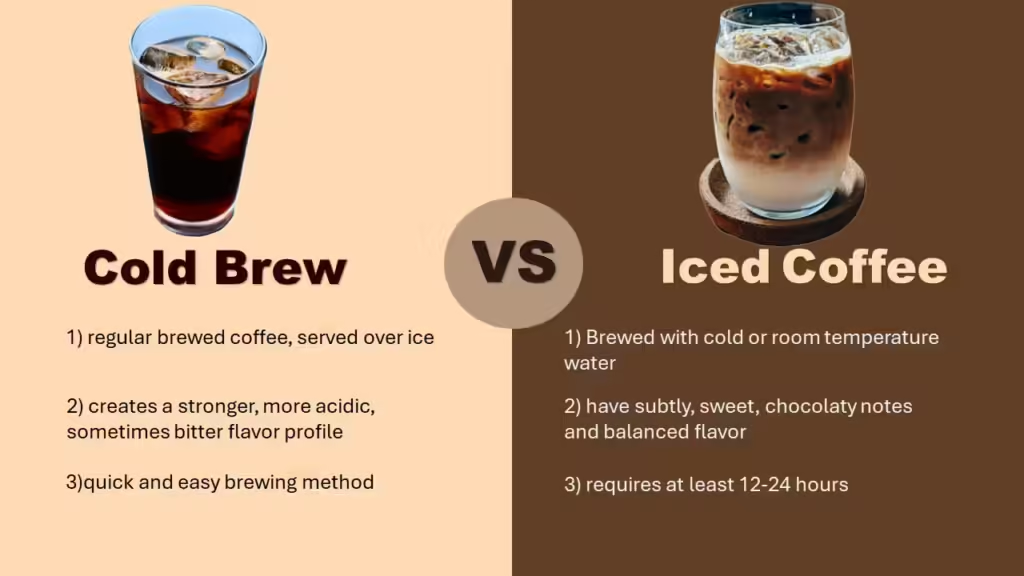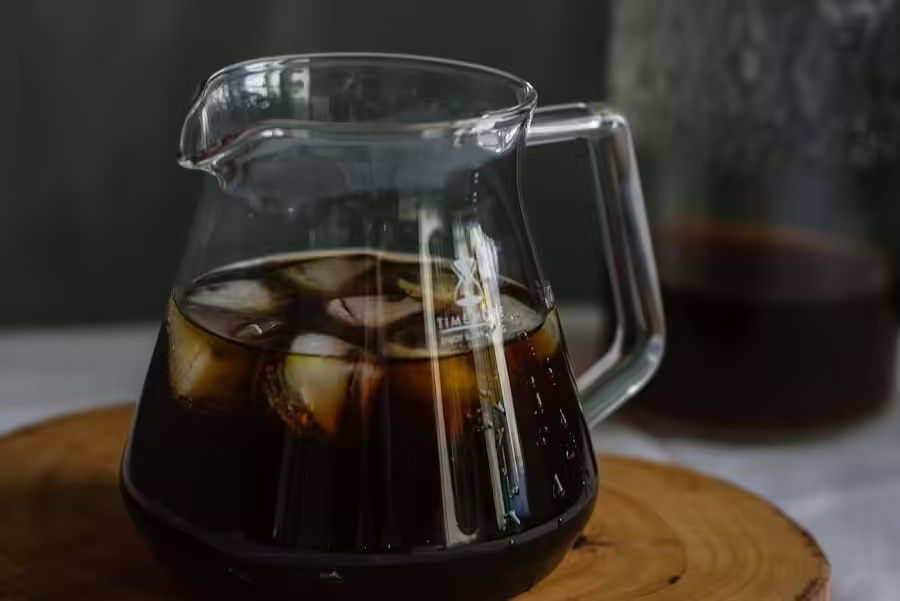As the season changes, the coffee drinking rituals are most likely to change with them. I’m talking about swapping that hot cup of morning coffee to something chilled, refreshing, creamy iced alternatives. I don’t know about you but for me it’s iced coffee all around the year.
The real question is, which do you prefer: cold brew or creamy iced coffee?
Many specialty coffee shops now serve cold brew; some offer only iced coffee, and others serve both. Both cold brew and iced coffee are served over ice, they each have distinct flavor profiles, brewing methods, and caffeine content. This raises the question: What’s the difference between iced coffee and cold brew? No matter which one you prefer, understanding the difference enhances your appreciation for each.
COLD BREW VS ICED COFFEE
WHAT’S THE DIFFERENCE
Iced coffee is just hot coffee served over ice; cold brew, on the other hand, is brewed with cold or room temperature water. The most important difference between cold brew and iced coffee is in the flavor when compared directly.

Cold brew is usually made by steeping coffee grounds in water for several hours. The cool water takes time to extract all the goodness from the coffee, resulting in a brew with very little acidity or bitterness. This process creates a smoother, slightly sweeter flavor that’s perfect for those who prefer a milder coffee experience.
Iced coffee on the other hand, can be made as pour over or using a decent coffee maker. Since it’s brewed with hot water, it’s going to have more acidity and bitterness compared to cold brew coffee. Hot water extracts the oils from the coffee beans, which is where the acidity comes from. You can enjoy your iced coffee with cream or milk, which will give you a refreshing pick-me-up throughout the summer.
COLD BREW (BREWING PROCESS)
So, let’s start by talking about what specifically is cold brew and how to make it. The brewing process for cold brew is actually very simple; you don’t need any special equipment to make a cold brew at home. You just need to combine coarsely ground coffee and water for at least 12–24 hours. This coffee slowly steeps either at room temperature or in the fridge, which results in a different flavor from iced coffee.
To make cold brew, start by adding 200 grams of coarsely ground coffee to a mason jar. Although you can use an espresso blend, coarsely ground coffee yields the best results for cold brew. Next, pour in 250 grams of water and mix thoroughly to ensure all the grounds are fully saturated. After that, place the jar in the refrigerator and let it steep for 16 hours. While I prefer 16 hours, anything between 12 to 24 hours works well. What you’re making here is cold brew concentrate, which can be stored for up to two weeks. One major benefit of this concentrate is its versatility—you can mix it with water or milk at a typical ratio of 1:2. The beauty of this method is that you have complete control over the strength of your cold brew, allowing you to dilute it perfectly to suit your taste.
ICED COFFEE(BREWING PROCESS)
Iced coffee is simply brewed coffee served over ice. You can brew your regular coffee using methods like a French press, Moka pot, pour-over, or even without a coffee machine. If you want to get the job done with whatever you have in your kitchen, we have got you covered. After brewing, let the coffee sit before serving, either by leaving it out or chilling it in the fridge. The cooling process makes iced coffee more robust and sometimes even sweeter. Now, it’s time to get creative—you can enjoy it straight over ice or add milk, cream, syrups, or any other ingredients you like. The sky’s the limit, and you can experiment to find your perfect flavor combination.
DOES COLD BREW AND ICED COFFEE TASTE DIFFERENT?
As earlier stated, the most significant difference lies in the flavor.
The creamiest Cold Brew involves steeping coarsely ground coffee beans in the water. It is widely known for its smooth, mellow, and sweet taste. Due to the absence of heat, the oils and acids that create the bright, more acidic notes of certain coffee are not extracted properly. As a result, the drink will have subtly sweet, chocolatey notes, and a balanced flavor. Cold brew is versatile enough to dilute with water or milk of your choice to make the finished product. It can also be used as an ingredient in items like Frappe, Cocktails, and even in cooking.
Iced coffee is simply brewed coffee served over ice. During brewing, the process extracts all the flavors and oils from the coffee grounds, resulting in a stronger, more acidic, and slightly bitter flavor profile. Because iced coffee is chilled, it can sometimes taste a bit more muted than hot coffee. In fact, regular iced coffee often tastes like a cup of hot coffee that was left to cool down on the counter. However, you can easily enhance its flavor by adding more or less cream or milk to suit your taste. For an extra kick, consider adding syrups, spices, or even a splash of flavored liqueur.
WHATS STRONGER? COLD BREW OR ICED COFFEE
Generally, cold brew contains more caffeine than a typical cup of iced coffee. When you compare equal amounts, cold brew has a higher caffeine content due to its brewing process. Cold brew uses a much greater ratio of coffee to water, resulting in a more concentrated brew. This process allows the coffee to slowly infuse into the water, enhancing both the strength of flavor and the caffeine content. The slow infusion also creates a smoother, yet stronger, taste compared to iced coffee. So, now you know, cold brew is stronger than iced coffee. No matter which is your preferred drink, you’ll be sure to enjoy the smooth taste in both.
BEST COFFEE BEANS FOR COLD BREW AND ICED COFFEE
Cold brew comes from good beans. Use your favorite beans, or ideally use a locally sourced, maybe freshly roasted coffee. I highly recommend thinking about making it with something that’s a bit more nutty, chocolaty, and kind of fruity. Usually, bright coffees don’t tend to do well in this application. In terms of origin, the heavy body and fruity flavors of natural or honey processed coffees will work better with cold brew. The deep fruity sweetness of Ethiopian natural or the heavy chocolaty flavors of a Brazil pulped natural coffee are right on the money for a cold brew. You can experiment with different coffees to see what you like and enjoy.
First and foremost, you need to choose the right beans and look for high quality freshly roasted coffee to get the best flavor. A light or medium roasted coffee with lots of natural sweetness will give you the best result at a lower temperature. So, natural or honey processed coffees are best when you’re trying to do iced coffee. Washed coffee can also produce a very refreshing flavor. There are no hard and fast rules for coffees. So, make your own search and find out what works best for you.
SO, WHAT’S YOUR FAVOURITE? COLD BREW OR ICED COFFEE
Now, the moment of truth: which one have you decided on? Let me make it easier for you.
You don’t even need to pick a favorite; you can enjoy both whenever you want. What’s important is that you’re getting what you want.
If you prefer a bright, refreshing coffee with a crisp bite at the end, go for iced coffee. It offers a traditional balance of acidity and sweetness that will definitely make you happy.
On the other hand, if you like something less acidic, sweeter in aroma, and with a smooth texture, cold brew is your best choice. Now that the flavor mystery has unfolded, I wish you a wonderful day and a delicious cup of coffee.

